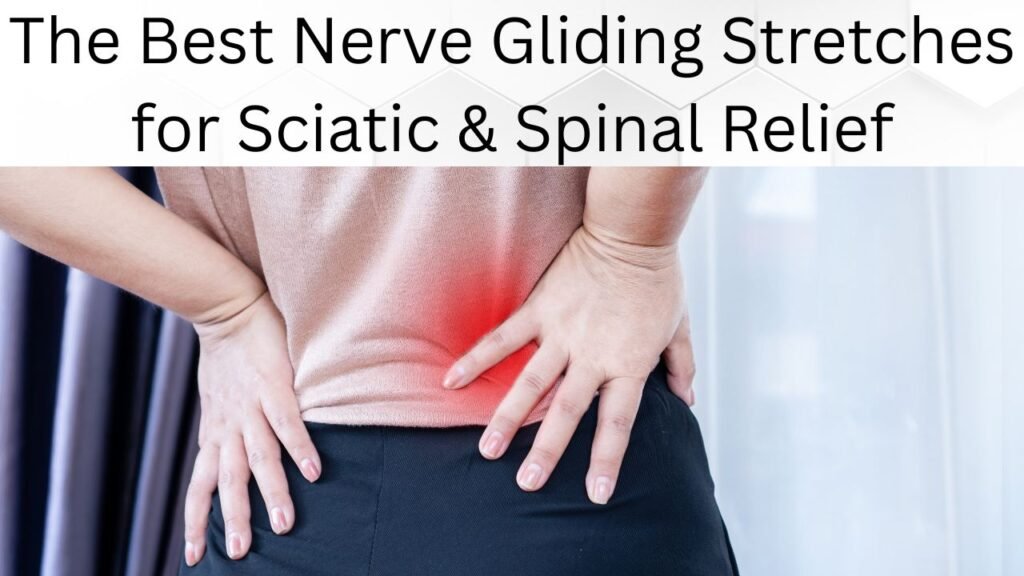Nerve gliding stretches, also known as nerve flossing, help mobilize compressed nerves and improve their function. These exercises are especially beneficial for sciatic nerve pain and spinal nerve compression. They can relieve discomfort, restore mobility, and enhance overall nerve health.
Understanding Nerve Gliding
Nerve gliding involves gentle movements that stretch and mobilize irritated nerves. Unlike static stretches, these exercises aim to restore normal nerve movement by reducing adhesions and tension along the nerve pathways.

Benefits of Nerve Gliding Stretches
- Alleviates pain from sciatic nerve compression
- Improves flexibility and range of motion
- Reduces stiffness caused by prolonged sitting or injury
- Enhances blood flow to nerves, supporting faster healing
Best Nerve Gliding Stretches for Sciatic & Spinal Relief
1. Sciatic Nerve Glide (Seated Nerve Flossing)
This stretch targets the sciatic nerve and improves mobility. How to do it:
- Sit on a chair with both feet flat on the floor.
- Extend one leg straight while keeping the other bent.
- Point and flex your foot while slightly tilting your head back.
- Repeat for 10-15 reps on each leg.
2. Hamstring Nerve Glide
Since the sciatic nerve runs along the hamstrings, this movement helps reduce tension. How to do it:
- Lie on your back and extend one leg upward.
- Hold behind your thigh and slowly straighten your knee.
- Flex and point your foot as you hold the stretch.
- Repeat for 10-15 reps per leg.
3. Lumbar Spine Nerve Glide
This stretch alleviates nerve compression in the lower back. How to do it:
- Lie on your back with knees bent and feet flat on the floor.
- Bring one knee toward your chest while keeping the other foot on the floor.
- Slowly straighten the leg while pointing and flexing your foot.
- Repeat for 10-12 reps per side.
4. Median Nerve Glide (For Upper Spine & Arms)
If you have nerve compression in the cervical spine, this stretch helps relieve symptoms in the arms. How to do it:
- Extend your arm to the side with the palm facing up.
- Slowly tilt your head away while extending your fingers.
- Return to the starting position and repeat 10-15 times.
5. Slump Stretch
This is an effective full-body nerve glide for spinal and sciatic relief. How to do it:
- Sit on the edge of a chair with legs extended.
- Tuck your chin to your chest and slouch slightly.
- Slowly extend one leg while pointing your toes upward.
- Hold for a moment, then return to start.
- Repeat for 10-12 reps per side.
6. Cervical Nerve Glide (Neck Nerve Flossing)
This stretch improves mobility in the cervical spine. How to do it:
- Sit upright and extend one arm outward.
- Tilt your head away while keeping the shoulder down.
- Hold for 5-10 seconds, then switch sides.
- Repeat for 10 reps per side.
7. Thoracic Nerve Mobilization
This stretch helps release tightness in the mid-back region. How to do it:
- Sit upright with hands clasped behind your head.
- Slowly arch your upper back over a chair or foam roller.
- Hold for 10-15 seconds and repeat 3-4 times.
Tips for Safe and Effective Nerve Gliding
- Start slowly: Avoid overstretching, as it may worsen symptoms.
- Control your movements: Perform each glide gently without forcing range of motion.
- Consistency is key: Do these stretches daily for long-term benefits.
- Warm up first: Light walking or mobility drills help prepare your body.
- Stop if pain worsens: If symptoms increase, consult a healthcare professional.
When to See a Doctor
If nerve pain persists despite regular stretching, seek medical attention. Symptoms like severe weakness, loss of sensation, or bladder dysfunction may indicate a serious issue requiring professional care.
Final Thoughts
Nerve gliding stretches are a powerful tool for sciatic and spinal relief. Incorporate these gentle movements into your routine to restore nerve mobility, reduce pain, and prevent future discomfort. Regular practice can make a significant difference in nerve health and overall well-being.